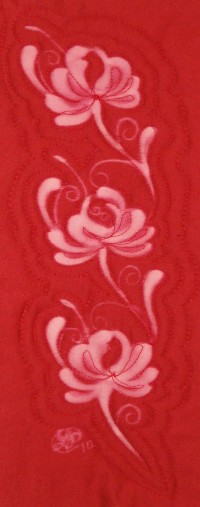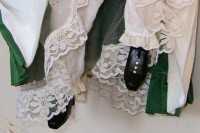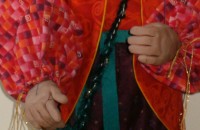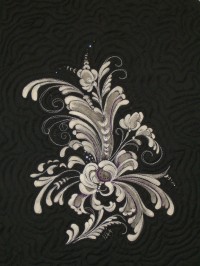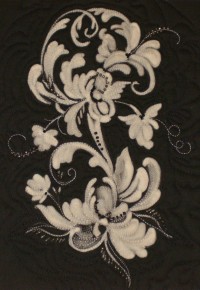The Perils of using Silk in your work
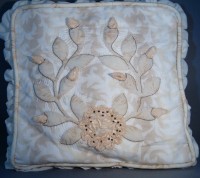 I took a hand appliqué class several years ago. The project was this wonderful little pillow with a design reminiscent of a Baltimore Album square. The fabrics were supplied by the teacher, some probably from her stash. The lovely monochrome color scheme and the use of silk for the flower buds and rouched blossom added a sophistication to the design.
I took a hand appliqué class several years ago. The project was this wonderful little pillow with a design reminiscent of a Baltimore Album square. The fabrics were supplied by the teacher, some probably from her stash. The lovely monochrome color scheme and the use of silk for the flower buds and rouched blossom added a sophistication to the design.
The little pillow has been a part of the collection on my living room couch during the summer and part of the dining room collection the rest of the year. It has been admired and handled gently as interesting pillows will be. Recently I noticed that there were tiny pieces of what looked like fine threads here and there on the couch. On closer inspection I realized that the silk buds and rouched blossom were the source of the minute threads. The beautiful silk had begun to fracture.
All that work and it was disintegrating before my eyes. There was no way of knowing how old the silk was when I used it, and using some kind of stabilizer would not have been an option as it would have increased the bulk of the delicate buds and prevented the soft folds in the rouched blossom.
Needless to say, I am very disappointed. Replacing the silk elements is certainly a possibility but it means removing some of the decorative embroidery and beading as well. Somehow things never seem to go back together looking unaltered but I will give it a try – some day!
The lessons I have learned are: know the age and history of your fabrics when at all possible, and choose fabrics that are the most stable and sturdy for the purpose intended. A better choice than silk for a piece that is subject to light, temperature, humidity and handling would have been an imitation silk. They are amazingly silk-like with a soft hand and drape. Because they are made from man made fibers like nylon and etc. they are stable and sturdy without the fracturing over time.
The final lesson is: be able to live with the choices you make because repairs are costly in time and counter productive. If you are selling or giving away your creations you do not want them to come back because of poor choices in materials or workmanship.
We all love to use antique and recycled textiles in our work – they are charming and responsible. However, if you want your hard work to last, be aware of their content and condition. Linen seems to last for ever, silk not so much.
Choose wisely!
Have you had a similar experience with older textiles? Let us know. Leave a comment.
Ever curious,
Linda


